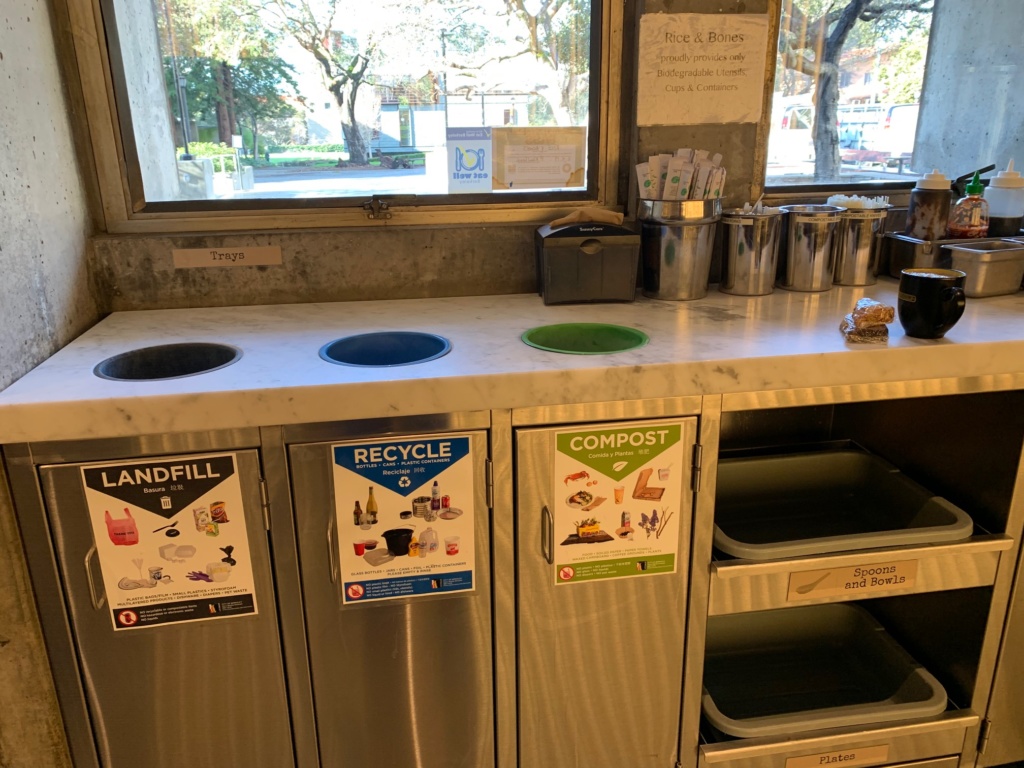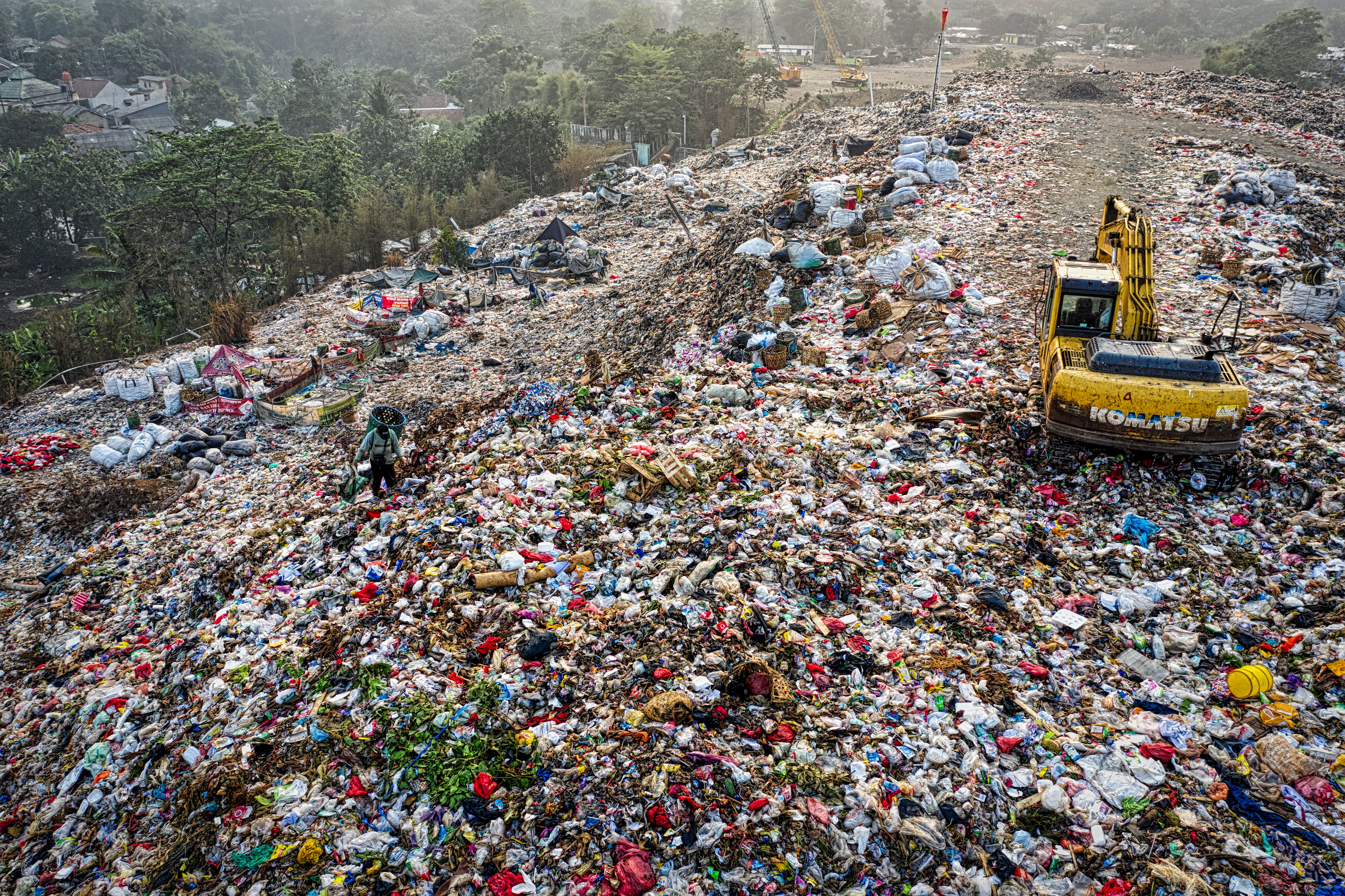
Published 15 January 2020, updated 23 August 2020
Zero Waste Goals @ Work
The University I work at has a goal of reducing the waste sent to landfills by 90% by end of 2020. In 2019, they reported that they were at ~54%. How this goal going to be achieved, is by putting compostable and recyclable materials into the right bins; reducing usage of packaging, plastics, and single-use products; and relying more on reused products.
What this means, practically, is that it is almost impossible now to find a general waste garbage can on campus. I can find compost bins, paper recycling bins, and bottles/cans bins, but no waste bins. So when I walk my dog on their lush green grass and protected, yet open fields, I wind up taking the poop-bag home with me to put in the garbage. Yuck. (Although, thinking about it now, does this waste count as compost if I use a compostable bag?)
Zero Waste Goals @ Home
At home, there are three ways to recycle, the first is by curbside pickup and the second is by a drop off recycling center.
Curbside Pickup
- The curbside recycling is for: paper, cardboard, cans, bottles, and plastic containers that are all empty, clean, and dry.
- The drop off recycling center allows: cardboard, paper, metals, plastic, electronic waste, batteries, exercise equipment, fluorescent tubes and CFLS, Sharps, syringes, motor oil, and pharmaceuticals.
- The drop off center accepts for donations: bicycles, books, magazines, corks, eye glasses, non-perishable food for food banks, hangers, and clothing, shoes, and household linens in clean, dry, reusable condition can also be donated to the Donation Station.
City Donation Station
So while the curbside recycling pick up is limited, I have the smallest waste receptacle our waste management company provides, my goal is to not fill it up each week. The point is, to get to zero waste at home I have to review what I am actually throwing out. So I did that last week and found that I:
- did not recycle all the paper or plastic
- threw out food stuff that could have gone into the compost bin
- did manage to donate items, rather than dispose (YAY)
- Still had too much plastic packaging that is not recyclable
Citywide Free Sharing
We utilize a local, citywide listing board called “Buy Nothing El Cerrito,” and I am told most city’s are now having these boards. Any item we have that cannot be recycled, we post on this listing board. Anyone who wants it, signs up and comes by to pick it up off the porch. Great way to pass on perfectly usable items. We have pickup boxes we needed to move some things, and have given away perfectly usable kitchen items.

Reducing Waste Actions
Refuse to Accept Refuse
First, we start with our decisions and our ability to say “NO”. Can we actually say “no” to additional plastic bags by bringing our own? Can we buy items that come without packaging or limited packaging? Can we say “no” to all unsustainable, waste producing food or kitchen items? This may also mean not buying every gadget that claims to save time.
Part of waste reduction is to buy the long lasting standard cooking equipment and utensils that will not have to be thrown away after a year or two of use. By spending a bit more for quality, can we reduce waste?
We can also decide to become obsessive with recycling everything that comes our way. All paper, plastic, cans, jars, bottles, foil, etc. This means each week our recycling and compost bins should be full, while landfill waste is reduced.

Reuse Everything Before Trashing
Second, my family tries to reuse everything before it gets recycled so, for instance, the plastic bags are recycled only after many, many uses. Examples of what we use the plastic bags for is carting items, dog poop or kitty litter collections, wrapping veggies up again in them (after cleaning), etc.
I reuse the containers we get when ordering soup to go. I reuse plastic forks and spoons by washing them and taking them to work where we all use them for our lunches multiple times. Those plastic baggies we all have, are washed and reused until they tear and then I collect all the plastic bags in one larger one and recycle.

Use Reusable or Compostable Items
Third, getting to zero waste also requires we exchange disposable items for reusable. For instance, changing out one-time-use paper towels for bamboo towels which can be cleaned and reused a number of times and then put in compost afterwards.
- I have these bamboo towels at work and they function very well over multiple times of hand washing and drying
- When they finally need to be tossed they go right into the compost bin at work

Compost or Use Composting Bins
Fourth, food composting is a requirement for home waste reduction because foods and stuff related to cooking and eating make up a lot of the landfill waste. The choice I have is to create a compost bin out back, or our waste company provides a green bin that can contain all garden waste and over the last couple of years has included compost.
- So all the food parts we do not want to cook with, can go into compost like the corn cob, husks and those annoying bean strings, etc. Or what I tend to do is make a broth with those items first, and then compost the left overs.
- All the moldy or frozen foods you obviously do not want to eat can go into compost, although it is recommended to place this stuff in the center of the compost and cover with dried plant material for quicker decomposition.
- Dried herbs, old spices, old seeds or nuts, all can be added to your compost pile.
- An occasional citrus rind won’t hurt either.
Composting non-Food Kitchen Items
- Plain wooden chopsticks, wooden toothpicks, and wooden matchsticks can go in the compost.
- Tea bags (not the ones with plastic) or paper coffee filters, egg shells, paper grocery bags, olive and other food pits, skins and rinds.
- Even plain cotton kitchen towels, although I read it is best to rip or cut them into strips first (personally I reuse old kitchen towels as rags).
- You can also add plain napkins, plain unwaxed paper plates, etc., if these items are not bleached or dyed.
Composting Personal Body Discards
- Dog, cat or human hair and nail clippings can be added to compost.
- Even the dust collected in the vacuum can go into a compost pile.
There are some things that can be added to compost bins that WILL attract animals. In my neighborhood we have raccoons, wild turkeys, deer, a very fat skunk, possums, voles, all of whom would be attracted to these other things that can go into compost
- Fish parts, bread, pasta, peanut shells, pie crusts, and end bits of cheese
- Leftover non-microwave popcorn (although ants may come to visit if there is salt and butter).

Grow and Preserve
Fifth, grow and preserve our own food. No one-time-use containers, no shopping bags, no driving to the store, just pluck, wash and eat. The main issue here is what to do with excess. Obviously, the thing to do is share the bounty with those in need, can, or freeze.
Donate Not Dispose
Sixth, and final idea, is to donate any food items still edible but that we do not want. Hungry people are in all cities and towns and what is thrown away can help feed.
- There are times my garden produces too much for my household.
- I give food to neighbors, people I work with, and people who work for me.
- Or I can the food and share those with neighbors.
- Or I leave bags out for workers who may come to my house: yard workers, mail carriers, housecleaners, tree trimers, whomever.
- Pass on cooking and other home equipment.
- It is placed in a freebie space for students since many cannot afford to buy stuff for a kitchen when they are first starting out.
It Can Be Done
Great Big History (this links to a video about their story) has done a video about the Japanese village of Kamikatsu, which has taken a commitment to sustainability seriously. The story indicates that while Japan has a recycling rate of ~20%, Kamikatsu has reached ~80%. They prove it is possible, but it requires that we, personally, change.
For comparison purposes, in 2013 USA recycled ~34.8% of its waste. But this is tempered by the awful reality that 91% of all recycled plastic is NOT actually recycled, but wind up in landfills.
What do you think? Could you go waste free in the next year or two? I do not think I can go wholly waste free but can work on lowering my land-fill amount by heavier recycling and better shopping.
–Patty
–**–
Tip: You need the right tools to do a given job. The basic tool a cook needs is a knife, so spend time and money finding the one that specifically fits your hand and feels good. But that alone is not enough, you need the correct knife for the given task. Generally I do most things with my Chef knife, but I have a serrated bread knife (great for bread, pastries, tomatoes and other squishy veggie or fruit), a paring knife, a boning knife, and I use a regular serrated steak knife when I need that type of cutting. I also use shears, nothing beats them when you need to cut up tough parts.
News: FoxNews reports It’s not known exactly how much of our individual exposure comes from food packaging. But what the study did show is that people who cooked at home more often had lower levels of PFAS in their blood than those that ate out more frequently. Consumer Reports says there are several things you can do to limit your exposure, starting with eating more fresh food. When you do eat out or order takeout, it’s worth unwrapping the food as soon as you can. And don’t store or reheat it in the containers it came in. The study also cites a notable exception to the cook-at-home rule: microwave popcorn. People who reported eating it often had higher levels of certain PFAS chemicals in their blood. So limit how much microwave popcorn you eat.
TidBit: A BBC documentary on eating stated that, on average, a British person spends the equivalent of 3 .5 years during their lifetime just in eating.
katana